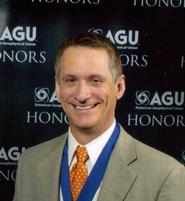
Eugene Domack, The J.W. Johnson Family Professor of Geosciences at Hamilton, has been named a Fellow of the American Association for the Advancement of Science (AAAS). Election as an AAAS Fellow is an honor bestowed upon AAAS members by their peers.
Domack was awarded the honor “For seminal contributions to our understanding of the quaternary history of the circum-Antarctic offshore region, and for engaging scores of undergraduates in the excitement of Antarctic paleoceanographic field work.”
This year 702 members were awarded this honor by AAAS because of their scientifically or socially distinguished efforts to advance science or its applications. New Fellows will be honored on February 16 at the AAAS Fellows Forum during the 2013 AAAS Annual Meeting in Boston, Mass.
Domack was elected a Fellow of the American Geophysical Union (AGU) in December, 2011. Specializing in the sediments, paleoenvironments, and glacial geology of the Southern Hemisphere, he has been the chief scientist aboard many research vessels to Antarctica. Over the last 15 years he has led more than 100 undergraduates to Antarctica as part of his NSF-sponsored research program. Domack has published many articles for journals such as Nature, Antarctic Science, Marine Geology, and Geological Society of America Bulletin, and has also edited the book, The Earth's Glacial Record.
Most recently, in October Domack undertook an 18-day cruise to Antarctica along with two Hamilton students and two alumni. The researchers were engaged in collecting and analyzing ocean floor sediment core samples from the western drainage of the Bruce Plateau Ice Dome. They plan to test findings from previous expeditions for which Domack served as principal investigator.
The team also installed a cGPS station, the seventh of its kind on the Antarctic Peninsula and a part of the cGPS network established by the LARISSA (LARsen Ice Shelf System, Antarctica) project. These stations continuously transmit meteorological data and elevation data to enable researchers to quantify crustal rebound and determine how it relates to warming and ice mass loss/gain on the Antarctic Peninsula.
The tradition of AAAS Fellows began in 1874. Currently, members can be considered for the rank of Fellow if nominated by the steering groups of the Association’s 24 sections, or by any three Fellows who are current AAAS members, or by the AAAS chief executive officer.
The AAAS is the world’s largest general scientific society, and publisher of the journal, Science as well as Science Translational Medicine and Science Signaling. AAAS was founded in 1848, and includes 261 affiliated societies and academies of science, serving 10 million individuals. Science has the largest paid circulation of any peer-reviewed general science journal in the world, with an estimated total readership of one million. The non-profit AAAS is open to all and fulfills its mission to “advance science and serve society” through initiatives in science policy, international programs, science education and more.
Posted November 30, 2012
